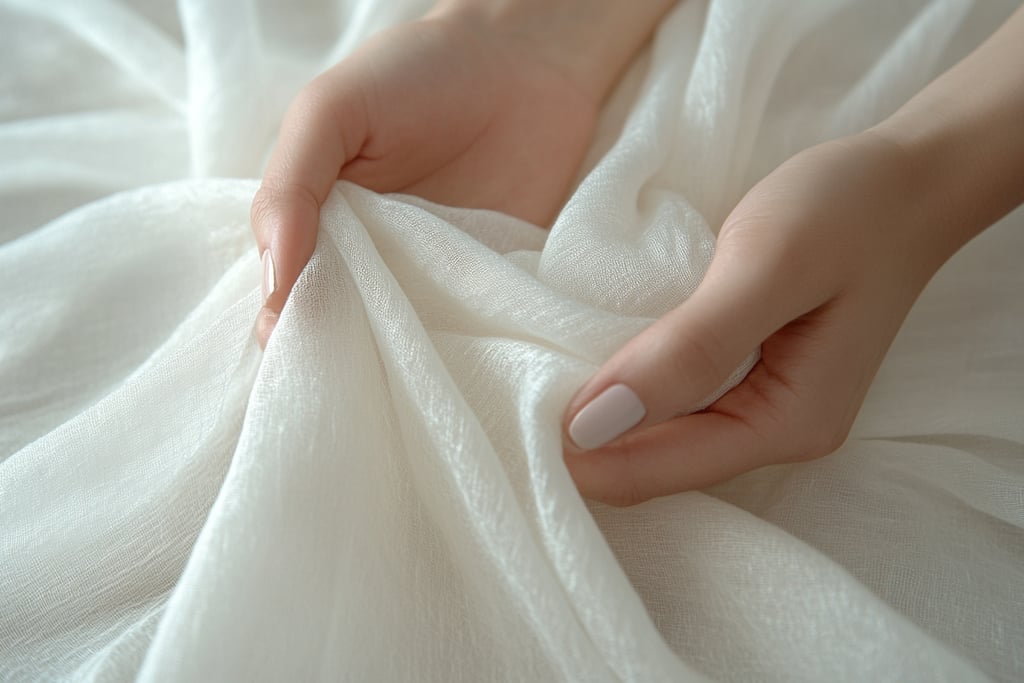Washing and Care Tips According to Fabric Content
For our clothes to last longer, proper care and cleaning are essential.
Eser Erkachan
11/16/20243 min read


Washing and Care Tips According to Fabric Content
For our clothes to last longer, proper care and cleaning are essential. Since each fabric type has different characteristics, applying the right care instructions helps preserve the quality of the fabric and ensures long-lasting wear. In this article, I will share the correct washing and usage tips for some of the most common fabric types. By taking a mindful approach to both your clothes and the environment, you can extend the lifespan of your fabrics.
1. 100% Cotton Fabrics: Natural, Comfortable, and Delicate
Cotton is one of the most widely used natural fabrics. Known for its comfort and breathability, cotton fabrics can shrink and lose color when exposed to heat and water.
Washing Tips:
Temperature: It is best to wash 100% cotton fabrics in lukewarm water (30-40°C). Hot water can cause the fabric to shrink and lose its shape.
Detergent: Use gentle detergents designed for colored fabrics to help keep the fabric vibrant for longer.
Drying: Cotton fabrics can be machine dried, but make sure to use a low heat setting. Air drying naturally helps preserve cotton fabrics.
Usage Tips:
Ironing: Cotton fabrics require hot ironing. It’s best to iron the clothes while they are still slightly damp.
Shrinkage Risk: Cotton garments may shrink slightly after washing. Following the washing instructions can help minimize this effect.
2. Wool Blend Fabrics: Elegant and Durable
Wool is an excellent insulator, known for trapping body heat. Wool-blend fabrics combine the elegance and durability of wool with the benefits of other synthetic or natural materials. However, wool is a delicate fabric and requires proper care.
Washing Tips:
Temperature: Wool fabrics should be washed in cold water (below 30°C). Hot water can cause wool to felt and lose its shape.
Detergent: Use gentle detergents specifically designed for wool. Wool fabrics are sensitive to harsher detergents.
Drying: The best method is to dry wool garments by hanging. Machine drying can cause them to lose their shape and shrink.
Usage Tips:
Ironing: Wool fabrics should be ironed at low temperatures. Using steam during the ironing process is the best way to smooth out the fabric.
Storage: Store wool garments in a cool, dry place. If possible, always keep them in a well-ventilated area.
3. PES Blend Fabrics: Durable and Low Maintenance
PES (Polyester) is a synthetic fabric known for its durability and ability to retain colors for a long time. Polyester blend fabrics are typically elastic and wrinkle-resistant, making them easy to care for and popular in everyday wear.
Washing Tips:
Temperature: Wash polyester blend fabrics in cold water to enhance their durability and prevent color fading.
Detergent: Most detergents can be used, but avoid those with strong chemicals.
Drying: Polyester fabrics can be machine dried, but it’s better to use a low heat setting to avoid damage.
Usage Tips:
Ironing: Polyester typically does not require ironing because of its wrinkle-resistant nature. However, if necessary, use a low heat setting when ironing.
Storage: Polyester fabrics are highly durable, so there’s no special storage requirement.
4. Viscose and Tencel Blend Fabrics: Soft and Stylish
Viscose and Tencel are semi-synthetic fabrics made from natural materials that undergo chemical processing. These fabrics are lightweight and soft, but they require careful maintenance.
Washing Tips:
Temperature: Viscose and Tencel fabrics should be washed in lukewarm water (30-40°C). Hot water can cause the fabric to shrink.
Detergent: Use gentle, specialized detergents and avoid heavy chemicals.
Drying: The best drying method is to air dry the fabric. Machine drying can lead to shrinkage and shape loss.
Usage Tips:
Ironing: Viscose and Tencel fabrics should be ironed at low temperatures. Ironing while the fabric is still slightly damp will give the best results.
Storage: Store these fabrics in a cool, dry, and well-ventilated area. These fabrics can be sensitive to moisture.
Conclusion
Each fabric type has its own unique characteristics and care requirements. By following the proper washing and care instructions, you can prolong the life of your textiles and keep them looking stylish. Adopting a fashion and environmentally friendly approach not only helps you use your clothes for longer, but it also fosters a sustainable shopping habit.
Every small step you take in fabric care not only extends the lifespan of your clothes but also reduces your impact on the environment. I hope this article has helped you with the right care tips, so you can keep your textile products healthy and stylish for a longer time, no matter the fabric type!
Certificates






Erkachan Tekstil Dış Ticaret A.Ş.
Hacıeyüplü Mah. 7513 Sokak No:3, 20050, Merkezefendi, Denizli, Türkiye
Tel: +90 530 919 2040
E-mail: info@erkachan.com
Get in Touch
www.erkachan.com
Site map
